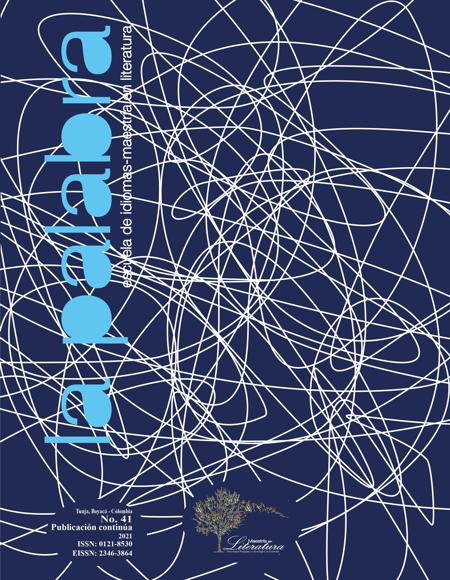Labyrinth, Crime and Local Bestiary: Didactic Strategies to Using Traditional Narrative in the Class

Abstract
In this article, the design of three teaching strategies is proposed to using in class. These strategies are applied to legends that belong to a corpus of traditional literature collected by the project “Reading and writing in Boyacá’s countryside”. The project suggests a teaching sequence composed by objectives, form of text presentation, thematic contents, activities, and evaluation criteria. To developing the sequence, it has made three ludic scenarios that gave value to different central aspects of legends as a literary genre: “the labyrinth of doors in the castle of crying”, “the research about the kidnap of a child”, and a kind of “local bestiary”. Before the application of each teaching strategy, the article observes the characteristics of the genre, and it is defined. Finally, it proposes the classification of legends to categorize the collected stories. This study contributes, previously, to an understanding of the thematic content of the three teaching strategies.
Keywords
Legend, didactics, traditional literature, oral literature, reading
References
- Agencia Cultural de Tunja del Banco de la República, Arquidiócesis de Tunja y Fundación Universitaria Juan de Castellanos. Proyecto: Escrituras y lecturas en la ruralidad boyacense. Artesanos del perdón, la reconciliación y la paz. Corpus de trabajo de campo. (2018-2019). Inédito.
- Altamirano Flores, Federico. “Didáctica de la literatura: ¿cómo se contagia la literatura?” La Palabra, núm. 28 (ene.-jun. 2016): 155-171. Web. 25 Oct. 2020. https://doi. org/10.19053/01218530.4813 DOI: https://doi.org/10.19053/01218530.4813
- Castaño Blanco, Antonio. Hidromitología y lecturas. Aplicaciones en educación, cultura y turismo. Tesis doctoral. Universidad de Extremadura, Extremadura, 2014. Reposito- rio Institucional. Web. 25 Oct. 2020. http://dehesa.unex.es/handle/10662/2046
- Colombres, Adolfo. “Del mito al cuento. Oralidad. Rescate de la tradición oral y la memo- ria de América Latina y el Caribe”. Anuario, núm. 6-7 (1995): 19-22. Web. 30 Oct. 2020. http://www.lacult.unesco.org/docc/oralidad_06_07_19-22-del-mito-al-cuento. pdf
- Díaz González de Viana, Luis. “Amantes que se desvanecen en el tiempo: la memoria etno- gráfica o la compleja significación de las leyendas”. Revista de Antropología Social, núm. 17 (2008): 141-164. Web. 19 Jun. 2020. https://core.ac.uk/reader/38821660
- Faria, Cláudia y Graça Alves. “Nos longos caminhos do mar…”. Imaginários do Mar, uma antologia crítica. Editado por Carlos Clamote, Joana Gaspar, Clara Sarmento y Luís Sosa, Vol. 1. IELT–Universidade Nova, FSCH, 2020, pp. 121-138.
- Fernández Vizoso, Raquel. La narración oral en el aula de educación infantil. Trabajo de grado, Universidad Internacional de La Rioja, 2012. Web. 30 Oct. 2020. https://reu- nir.unir.net/bitstream/handle/123456789/490/Fernandez.Raquel.pdf?sequence=1&i- sAllowed=y
- López Valero, Amando y Eduardo Encabo Fernández. “De mitos, leyendas y cuentos: necesi- dad didáctica del género narrativo”. Contextos educativos, núm. 4 (2001): 241-250. Web. 29 Oct. 2020. https://doi.org/10.18172/con.495 DOI: https://doi.org/10.18172/con.495
- López Estupiñán, Laura. “Topando piedras, sumercé. Narraciones en torno a las piedras de Iza y Gámeza, Boyacá, Colombia. Primera parte”. Rupestre web, 2012. Web. 29 Oct. 2020. http://www.rupestreweb.info/topandopiedras.html
- Martos Núñez, Eloy y Alberto Martos García. “Las leyendas regionales como intangibles territoriales”. Investigaciones Regionales – Journal of Regional Research, núm. 33 (2015): 137-157. Web. 27 Jul. 2020. https://investigacionesregionales.org/es/article/ las-leyendas-regionales-como-intangibles-territoriales/
- Ministerio de Educación Nacional. Estándares básicos de competencias del Lenguaje. Coor- dinado por José Correa Medina. Ministerio de Educación Nacional, 2006. http:// www.mineducacion.gov.co/1621/articles-116042_archivo_pdf1.pdf
- Morote Magán, Pascuala. “Las leyendas y su valor didáctico”. Actas xl Congreso de AEPE, 2001, pp. 392-403. Web. 29 Oct. 2020. https://cvc.cervantes.es/ensenanza/bibliote- ca_ele/aepe/pdf/congreso_40/congreso_40_38.pdf
- Rodríguez Gonzalo, Carmen. “Programar en lengua y literatura”. Didáctica de la Lengua Castellana y la Literatura. Coordinado por Uri Ruiz Bikandi y María Dolores Abas- cal Vicente. Vol ii. Madrid, Ministerio de Educación, Cultura y Deporte / Secretaría General Técnica / Graó, 2011, pp. 35-59.
- Sistema de Información Turística de Boyacá. Iza. Petróglifos Vereda Usamena. (s.f.a). Web. 29 Oct. 2020. https://situr.boyaca.gov.co/atractivo-turistico/petroglifos-vereda-usa- mena/
- Sistema de Información Turística de Boyacá. Divino salvador de la piedra de Iza. (s.f.b). Web. 29 Oct. 2020. https://situr.boyaca.gov.co/atractivo-turistico/divino-salvador- de-la-piedra-de-iza/
